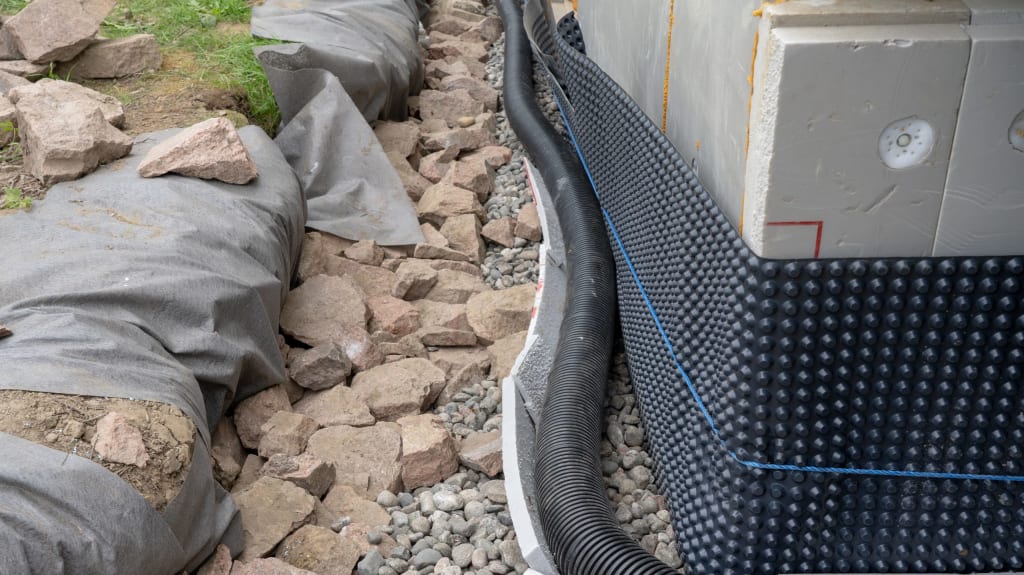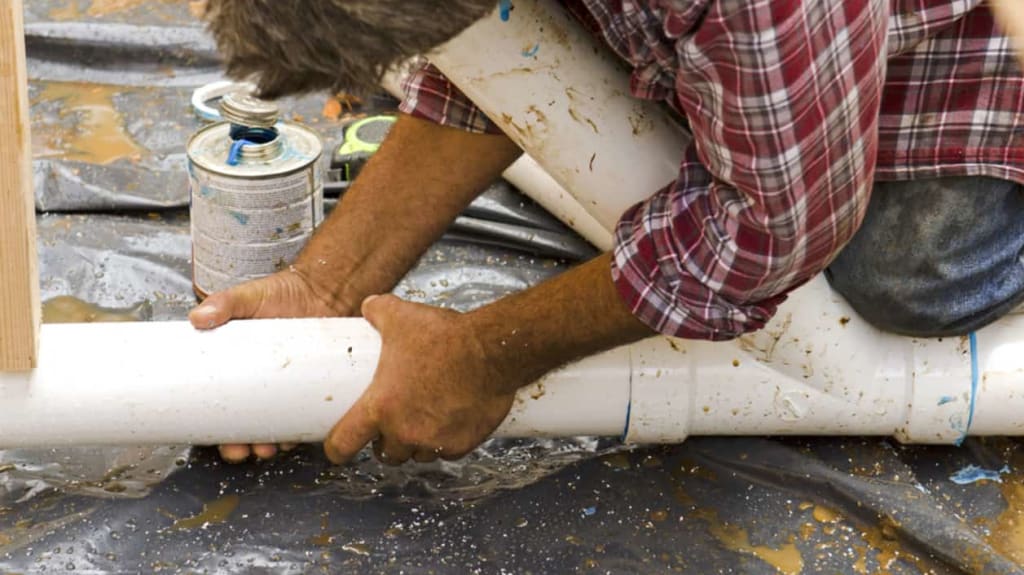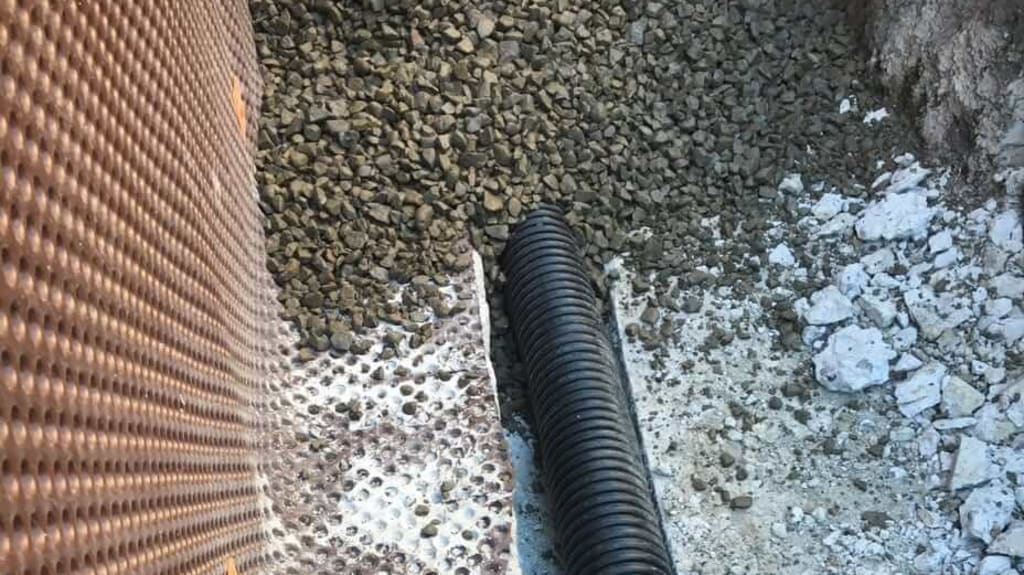Beneath the surface, soil holds vast amounts of water that exerts force (hydrostatic pressure) on the sides and underside of your home. This pressure can be dangerous: It can cause cracks in your foundation, leaks, and even mould! Thankfully, there are many methods to control groundwater and protect your home. Let’s go over the simplest and most effective one: weeping tile.
What is weeping tile?
In its simplest form, weeping tile is a perforated pipe. The holes in it allow it to collect groundwater and lead it elsewhere. We use it in drainage systems to protect our structures from damage caused by water beneath and beside the foundation. Weeping tile is usually used in French drains to form protective barriers around homes.
Are weeping tile and French drains the same thing?
While very related and often confused with each other, they are not synonymous.
Weeping tile is an old name given to drainage pipes. It used to be made of terracotta, a porous material that allowed water to seep through it or “weep.” Modern versions simply have holes.
French drains, on the other hand, get their name from Henry Flagg French, who designed and wrote about them in his paper on drainage systems in 1859. These involve digging a trench and filling it with gravel or similar stone, sometimes including weeping tile pipe installed at the bottom.
That said, the two are almost always used in the same systems. Most effective modern designs are French drains with weeping tile pipe.

How does weeping tile work?
The underground pipe has perforations along its length, allowing hydrostatic pressure to force water into the pipe. This water then gets directed through the pipe away from your home to a point where it can be safely discharged, such as a reservoir or storm drain. The stones often placed around it allow air and water to move more freely and enter the pipe as opposed to flowing elsewhere.
Do I need weeping tile?
If you live in a modern home, you likely already have weeping tile around your foundation. In Quebec, all homes built since 1955 must be equipped with a French drain. Older homes, however, often don’t have it since the Building Code didn’t require it when they were built. Nonetheless, you may need to install a French drain system or replace an existing one in the following circumstances.
Low elevation. Water is likely to collect around your house if it sits below most of the surrounding land. This can cause water damage and flooding.
Foundation damage. Existing water damage to your foundation is a clear sign that weeping tile will help your home’s longevity.
Retaining walls. If you have a retaining wall on your property, a weeping tile pipe should be installed at the base to address hydrostatic pressure.
Excess water. If you notice high humidity, water leaking in, or any musty odour, it’s likely that there’s excess water getting into your basement. There may also be excess water at the surface level around your home.
Pool. If you intend to have an outdoor pool on your property, it is a good idea to surround it with a French drain to allow splashed out water to drain away from your home.
If these don’t apply to your home or it’s built at the top of a hill, you likely won’t need weeping tile.

Quebec standards for French drains
French drains must have a minimum diameter of 100 mm (4 in.) and be covered on the sides and top by a layer of crushed stone at least 150 mm (6 in.) thick. In addition, the top of the drain must be below the underside of the basement slab. Drains must also lead to a sewer, ditch or lost well.

Thinking of renovating?
Pros and cons of a weeping tile system
Water buildup on your property may mean a weeping tile installation is your solution, though it is not without its drawbacks.
Pros:
Effective groundwater protection
Long (30+ year) lifespan
Low maintenance if installed properly
Cons:
High installation costs
Installation can be tricky and messy
Installing weeping tile
Some types of weeping tile installation can be done yourself, but if you are digging around or within your foundation, hiring a professional is advised. Important things to know about when planning new weeping tile are how to install it safely, where you want it installed, and what type of installation you want.
Getting approval
If you decide to put in a new weeping tile setup or repair an existing one, the first step is to call 811. They can mark all existing utility lines around your house and talk to you about any regional restrictions there may be. Next would be to check if you have a storm drain as a potential discharge location and to contact city hall to see if you can use it. Should you be able to, this is one of the most effective drainage locations. If you choose to hire a contractor, they will likely do these steps for you.

Layout and placement
Depending on the water issues, you have around your home, different French drain systems are needed. The exact layout will vary based on the shape of the property, where water will discharge, and any obstacles preventing installation where you would like.
Footing. This is the most common design of weeping tile; it’s placed along the perimeter of your foundation deeper underground. This prevents hydrostatic pressure from harming your foundation and basement walls.
Interior French drain. In the event that your basement is humid or water is still infiltrating, the right choice may be an interior French drain. This drain is installed under the concrete floor and will allow any water flowing into your basement to escape into a sump pump basin where it can be removed.
Curtain. Most effective when there is a slope leading down to your home, this is installed deep underground and away from your structure. It prevents water runoff from ever reaching your home and is especially helpful in high groundwater areas.
Exterior French drain. These are dug close to the surface near your home to dry out areas that gather water, such as low spots or near a pool.
Discharge. The water collected by the system has to go somewhere, and it’s important to determine this before installing. It may go to a sump pump and through the sewage system, out to a storm drain, or even into a dry well or reservoir.
Positive slope. No matter the installation, a slope is required. This should be angled up from the discharge point at least 1% grade, or water will simply stagnate in your pipes.
Inlets. One method of keeping the water away from your foundation is to catch it as it comes from your gutters using grates that connect to your French drain system.

Common French drain materials
There are many materials you can use to construct French drains, but three necessary ingredients are a type of weeping tile pipe, backfill material to fill the trench, and a fabric to line it.
Drainage pipe (weeping tile)
Here are the most common drainage pipes you’ll find on the market.
Big-O. This is the most commonly used drainage pipe, largely due to its price point and accessibility. It’s usually a black corrugated pipe made of HDPE plastic that has perforated valleys. Excess pressure can cause it to cave in.
PVC perforated pipes. These solid pipes are made of PVC and have circular perforations along the bottom edge. While they’re much stronger than standard HDPE pipes, less water flows through them. You also need to install backfill below to allow enough water to get in.
Multilayer rigid pipes. These specialty pipes (e.g., Baughman tiles) are designed to hold against higher pressure while allowing greater water flow. They’re made of HDPE and tend to be more expensive, but they’re extremely effective.

Backfill
Used to fill the void around and above the weeping tile, this material helps water flow into the French drain system.
Existing soil. While you can use soil excavated from the trench to save time and money, it isn’t conducive to efficient water flow and quickly clogs the pipes or crushes them.
0.75” clear gravel. A simple option for backfill is gravel. It’s cleaner and creates larger voids than dirt. Though it is more expensive, it is far more effective at allowing water flow.
1.5” round rock or river stone. The best option by far, river stone creates large voids. Its smooth surfaces allow water to flow quickly and lead to clogging far less than other options.

Filter fabric
Geotextile fabric lines the trench to provide strength and filtration while allowing water to flow.
No fabric. Not adding fabric to your trench will allow dirt and debris to clog the holes in your weeping tile pipe.
Woven vs unwoven. Woven fabric is generally used for structural support, whereas unwoven fabric is used for filtration and drainage. The latter is preferred when installing weeping tile.
Single vs double punched. This refers to the number of needles punched through the fabric when it was made, with more leading to better water flow. It is hard to find double punched fabric and it is often expensive, but in high flow environments it can easily be worth it.
Fabric weight. Landscaping fabric can be found in many weights, trading off water flow for strength as it increases. For French drains, 4 oz fabric is best, though 3–6 oz can be right for your construction.

Extras
While not necessary, there are some extra options for your French drain system.
Gutter catches. If you have a roof gutter draining directly into your French drain, a catch will prevent large debris from entering the system. This will make maintenance easier.
Pop-up emitters. An attachment to the end of or partway through your system, this allows water to escape when pressure is high enough.

How to install weeping tile
The methods of installing weeping tile vary slightly based on the materials you choose and the location of your home. Here’s the general process a contractor will follow.
Clear the area the weeping tile will be installed in and protect grass with plywood or something similar.
Dig a trench to the appropriate depth and slope, around two feet deep for surface drains and as low as your foundation for curtain and footing drains.
Repair cracks (if necessary) and waterproof the foundation.
Line the trench with filter fabric and pin the sides to the ground.
Place the pipe at the bottom of the trench on the fabric, excluding PVC pipe which will require some stone placed beneath it as well.
Backfill the rest of the trench with stone.
Fold over the filter fabric and pin it down.
Backfill with stone or dirt.
Clean up the area.
The contractor can omit the use of filter fabric and stone backfill if the client requests it, but this will lower the effectiveness and lifespan of your weeping tile.


Thinking of renovating?
How much does weeping tile cost?
The cost of a French drain system is heavily impacted by the materials selected, the project size, and the location. Here are the average price ranges for a French drain renovation project.
Type of French drain | Cost per linear foot |
Exterior footing | $15 to $70 |
Interior French drain | $55 to $135 |
Curtain drain | $15 to $50 |
Trench drain | $45 to $120 |
Higher quality materials will cost more but last longer.
Lifespan of weeping tile
New weeping tile installations last far longer when made of higher quality materials and installed correctly. If you’re using round stone, filter fabric, and quality tubing, it can last over 50 years. If it is simply big-O tubing in the bottom of a trench backfilled with soil, it may only last a few months.
The most common issue for the lifespan of weeping tile is clogging. Once drains are blocked, they’re difficult to clear since the system is buried deep underground. However, since the 1990s, French drains have been connected to chimneys, which give access to the drainage pipes. Usually located in the curbstones, these stacks provide easy access for drain inspections.
Maintenance for weeping tile
When installed correctly, maintenance should not be required. That said, if a clog has formed or the pipe is damaged, you may need professional help. Signs of required maintenance would be water buildup around the installation site or water not flowing to the discharge point. Another location to check for issues is the sump pump, which can be broken, not getting water, or even be filled with iron ochre.

Common problems with drainage
If you want to avoid drainage problems in your new weeping tile installation, here’s what to look out for.
No gutter connection. Roof drains should never lead directly into a weeping tile system. While a separate system is the best option, a catch basin with drain grates will also work.
Poor quality materials. Drainage problems often result from material choices, such as using dirt instead of rock for backfill or foregoing drainage fabric. This is also the case when the wrong type of filter fabric is used, or the stone is too small or coarse to allow fast drainage.
Lack of positive slope. If the pipes are not sufficiently sloping down away from your house, water will stagnate instead of draining away.
No outlet. Weeping tile without an outlet will just collect water in the pipe without taking it away from your home.
Ignoring greenery. Having healthy grass above your drains is very effective at allowing water to flow from the surface down to the pipes.
Are there any subsidies for French drains?
Government programs and municipal subsidies are sometimes available for the installation of French drains, but these are subject to regular change. The City of Montreal currently offers the RénoPlex program (French only), and the provincial government provides a grant that may apply to French drains when homeowners decide to insulate the foundation from the outside.
Wash away your worries with weeping tile
If you’re dealing with basement flooding or a swampy backyard every spring, then weeping tile and French drain systems can help. Not only will they remove excess water, but they’ll also prevent water damage to your home. Be sure to hire a certified professional – they’ll install an effective drainage system based on your needs. While you’re at it, you can also check out some ways to waterproof your basement.




